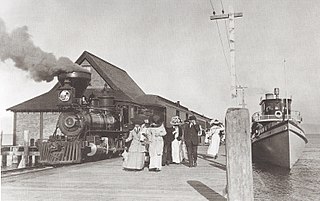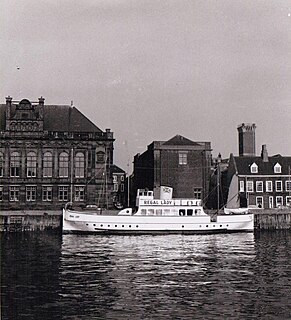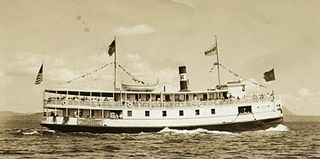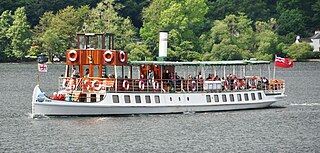
A paddle steamer is a steamship or steamboat powered by a steam engine that drives paddle wheels to propel the craft through the water. In antiquity, paddle wheelers followed the development of poles, oars and sails, where the first uses were wheelers driven by animals or humans.

SS Tahoe was a steamship that operated on Lake Tahoe at the end of the 19th century and the first half of the 20th. Scuttled in 1940, the wreck presently lies in 400 feet (120 m) of water off Glenbrook, Nevada. The wreck was first visited in 2002 by a team from New Millennium Dive Expeditions (NMDE) in a record-setting high-altitude dive for Lake Tahoe. As a result of the work that NMDE did on the Tahoe site from 1999 up to their dives in 2002, Tahoe became the first maritime site in Nevada to be listed in the National Register of Historic Places.

The steamship Virginia V is one of two last operational examples of Puget Sound Mosquito Fleet steamers. She was once part of a large fleet of small passenger and freight carrying ships that linked the islands and ports of Puget Sound in Washington state in the late 19th and early 20th centuries. She is a Seattle landmark and a National Historic Landmark.
The West Cornwall Steam Ship Company was established in 1870 to operate ferry services between Penzance, Cornwall, and the Isles of Scilly. It became the West Cornwall Steamship Company in 1907 and was wound up in 1917.

The MV Western Belle is a twinscrew passenger vessel. She is owned by Ullswater 'Steamers', who refitted her and launched her on Ullswater in Autumn 2010.

The MV Lady Wakefield is a twin screw passenger vessel, operating between Glenridding, Howtown and Pooley Bridge on Ullswater in the Lake District for Ullswater Navigation and Transit Co, marketed as Ullswater 'Steamers'.
Lake steamers of North America include large, steam-powered non-government vessels with displacement hulls on American freshwater lakes excluding the Great Lakes. They may have served as passenger boats, freighters, mail-boats, log-boom vessels or a combination thereof. The construction of such vessels posed unique problems on water bodies located away from established dry-docks and marine railways, or connecting canals to such facilities.

The MV Regal Lady is a 1930 built steel passenger boat moored at the port of Scarborough, North Yorkshire. She is a National Historic Ship, owned and preserved by Scarborough Pleasure Steamers. The ship participated in Operation Dynamo at Dunkirk, was decommissioned in 1946, and in 1954 was moved to Scarborough and renamed from Oulton Belle to its current name.

The Katahdin is a historic steamboat berthed on Moosehead Lake in Greenville, Maine. Built in 1914 at the Bath Iron Works, it at first served the tourist trade on the lake before being converted to a towboat hauling lumber. It was fully restored in the 1990s by the nonprofit Moosehead Maritime Museum, and is again giving tours on the lake. One of the very few surviving early lake boats in Maine, and the oldest vessel afloat built at Bath, it was listed on the National Register of Historic Places in 1978.

Kanangra and Kirawa were ferries on Sydney Harbour. Both vessels were near identical sister vessels and were launched in 1912 during the early-twentieth pre-Sydney Harbour Bridge boom years of Sydney Ferries Limited.

Ullswater 'Steamers' is a boat company which provides leisure trips on Ullswater in the north-eastern part of the English Lake District. It is based in Glenridding, Cumbria. Founded in 1855, it currently operates five diesel powered vessels between four locations on the lake. The oldest boat in its fleet was launched in 1877.

The MY Lady of the Lake is a passenger vessel operating for Ullswater 'Steamers' on the lake of Ullswater in the English Lake District, where she has spent her entire working life. She was built in 1877 as a steam vessel, but converted to diesel power in 1936. She is believed to be the oldest working passenger ferry in the world, and is a member of the National Historic Fleet.

The SS Atlanta was a wooden hulled Great Lakes steamer that sank in Lake Michigan off the coast of Cedar Grove, Wisconsin, United States, after burning down. Her wreckage still remains at the bottom of the lake, and on November 6, 2017, the wreck of the Atlanta was listed on the National Register of Historic Places.

Windermere Lake Cruises is a boat company which provides leisure trips on Windermere in the central part of the English Lake District. It is based in Bowness-on-Windermere, Cumbria.

SY Tern, now operating as MY Tern, is a passenger vessel on Windermere, England. Launched in 1891 she was built for the steamer service carrying passengers from the Furness Railway. She underwent several changes in owner as companies were merged throughout the twentieth century, and spent time as a sea cadet training ship during the Second World War. Refitted several times, her original steam engines have been replaced with diesel engines. Tern is the oldest vessel operating on Windermere, and is a member of the National Historic Fleet. She is currently operated by Windermere Lake Cruises as the flagship of their fleet.

The SS Raven, sometimes also referred to as the SY Raven, is a steam barge ordered by the Furness Railway for use on the lake of Windermere in the English Lake District, where she has spent her entire working life. She is a member of the National Historic Fleet, and is now preserved. She is the second oldest ship on Lloyd’s Register and the oldest with her original machinery.

The steamship General Frisbie was a wooden two-deck passenger ship built in 1900, named after John B. Frisbie. She was designed for use as a ferry between Vallejo and San Francisco. The steamer was successful in that role and was the fastest ship on the route when she began service. Improved roads, bridges, and automobiles reduced demand for ferry service in the Bay Area, and newer ships were optimized for transporting cars, so General Frisbie was retired in the late 1920s.

Kosciusko was a "K-class" ferry on Sydney Harbour. Launched in 1911, the timber-hulled steamer was built for Sydney Ferries Limited during the boom in cross-harbour ferry travel prior to the opening of the Sydney Harbour Bridge.

Sydney Harbour ferry services date back to the first years of Sydney's European settlement. Slow and sporadic boats ran along the Parramatta River from Sydney to Parramatta and served the agricultural settlements in between. By the mid-1830s, speculative ventures established regular services. From the late-nineteenth century the North Shore developed rapidly. A rail connection to Milsons Point took alighting ferry passengers up the North Shore line to Hornsby, New South Wales via North Sydney. Without a bridge connection, increasingly large fleets of steamers serviced the cross harbour routes and in the early twentieth century, Sydney Ferries Limited was the largest ferry operator in the world.




















